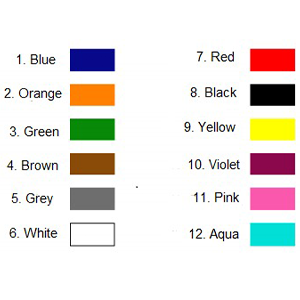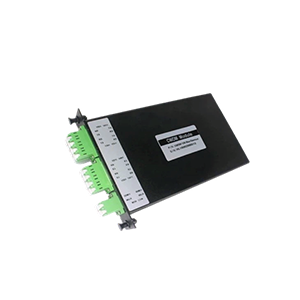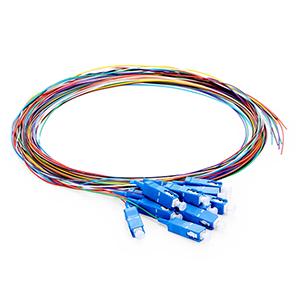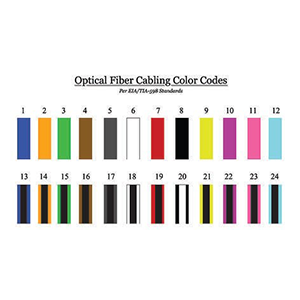Hello everyone, I am kun, an optical engineer at Gracyfiber. Today I will bring you a blog about what can fiber patch cords be used for. As an important part of the development of modern science and technology, fiber optic patch cords play a key role in various fields. Whether it is a data center network, local area network, optical fiber communication network, or video surveillance system, wireless base station connection and audio and video transmission, fiber optic jumper cables play an important role in connecting, transmitting and enhancing signals. In this blog post, I will introduce in detail the application value and characteristics of fiber optic patch cords in these fields and their important role in achieving high-speed and stable data transmission.
Data Center Network
Data center networks are critical infrastructure for storing, managing, and processing large amounts of data. In data center networks, fiber optic patch cords play an important role and have the following characteristics and importance:
Definition and characteristics:
- High bandwidth: Fiber optic jumper cables can provide high-bandwidth transmission to meet the needs of data center networks for large-capacity data streams.
- Low loss: Fiber optic jumper cable adopts fiber optic transmission technology, which has low signal attenuation and loss, ensuring that data maintains high quality during long-distance transmission.
- Anti-interference: Fiber optic jumper cables have high anti-interference capabilities against electromagnetic interference and radio frequency interference, ensuring the stability and reliability of data transmission.
- Slim and lightweight: Fiber optic jumper cables are slimmer and lighter than traditional copper cables, making the internal wiring of the data center more flexible and efficient.
Device connection:
- Server connection: Fiber optic jumper cables are used to connect servers in data centers to achieve fast and reliable data transmission and communication between servers. With fiber optic patch cords, servers can efficiently share data and resources.
- Storage device connection: Data centers usually use large-capacity storage devices, such as storage arrays (Storage Array) or network attached storage (Network Attached Storage, NAS). Fiber optic patch cords connect storage devices and servers to support high-speed, low-latency data access and storage.
- Network switch connections: Network switches in data center networks are responsible for routing and forwarding data flows. Fiber optic jumper cables connect network switches to build a high-performance, scalable data center network to achieve fast and reliable data exchange and forwarding.
High-speed transmission:
- High bandwidth requirements: Data center networks need to meet the high bandwidth requirements for large-scale data transmission. Fiber optic jumper cables provide high-bandwidth transmission capabilities through fiber optic transmission technology and support fast, large-capacity data transmission.
- Low latency: Data centers have high requirements for real-time and low latency of data transmission, especially for big data processing, cloud computing and real-time applications. The low transmission delay of fiber optic jumper cables can meet the real-time and responsiveness requirements of data center networks.
- Long-distance transmission: Data centers usually require data transmission between different computer rooms or floors. Fiber optic jumper cables have low signal attenuation and loss, can achieve long-distance data transmission, and support the expansion and flexibility of data centers.
Local Area Network
Local Area Network, LAN is a network established to connect multiple computers and devices within a limited geographical range. Fiber optic jumper cables have the following application values and characteristics in local area networks:
Definition and characteristics:
- High-speed transmission: Optical fiber jumper cable adopts optical fiber transmission technology, which has the characteristics of high bandwidth and low transmission delay, and can support high-speed data transmission needs in LAN, such as large file transmission, video streaming, etc.
- Anti-interference: Fiber optic jumper cables have high anti-interference capabilities against electromagnetic interference and radio frequency interference, ensuring the stability and reliability of data transmission and reducing the risk of data errors and packet loss.
- Long-distance transmission: The signal attenuation of fiber optic jumper cables is low, which can achieve long-distance data transmission. It is suitable for large buildings, campus networks and other LAN environments that need to span long distances.
Building wiring:
- Internal wiring: Fiber optic patch cords play a key role in LAN cabling inside buildings. Connect switches, routers and computers on different floors, rooms or office areas through fiber optic jumper cables to achieve high-speed, stable data communication and shared resources.
- Campus network: In large campus networks, fiber optic jumper cables are used to connect LANs between different buildings such as teaching buildings, laboratories, libraries, etc. Fiber optic patch cords can meet the needs of high-bandwidth, long-distance transmission and support rapid data exchange and resource sharing between students and faculty.
Signal transmission:
- High bandwidth requirements: The demand for data transmission in LAN is growing day by day, involving high-bandwidth applications such as large file transfer, video conferencing, and cloud applications. Fiber optic jumper cables provide high-bandwidth transmission capabilities and can meet the rapid transmission needs of large-capacity data in local area networks.
- Signal stability: Fiber optic jumper cables have strong resistance to signal attenuation and interference, which can ensure the stability and quality of the signal during transmission. This is very important for applications in local area networks that require high data accuracy and reliability.
- Security: The transmission method of fiber optic jumper cables is based on optical signals. Compared with traditional copper cables, fiber optic transmission has higher security. It is not easily eavesdropped or interfered with, providing more reliable data transmission and security that protects sensitive information.
Optical fiber communication network
Optical fiber communication networks use optical fiber transmission technology to transmit information in the form of optical signals. Optical fiber jumper cables play a key role in it and have the following characteristics and functions:
Definition and characteristics:
- High-bandwidth transmission: Optical fiber jumper cables use optical fiber transmission media, which can provide high-bandwidth transmission capabilities and meet the needs of optical fiber communication networks for large-capacity data transmission, such as high-definition video, cloud computing, big data transmission, etc.
- Low loss: Fiber optic jumper cables have low signal attenuation and transmission loss, which can achieve long-distance data transmission without reducing signal quality, ensuring the stability and reliability of fiber optic communication networks.
- Broadband transmission: Fiber optic jumper cables can support broadband transmission, which means transmitting signals in multiple frequency bands simultaneously, allowing fiber optic communication networks to carry multiple types of communication services, such as voice, data, and video.
Optical fiber transmission:
- Long-distance transmission: One of the great advantages of fiber optic patch cords is their ability to transmit data over long distances. Due to the low transmission attenuation of optical signals, fiber optic jumper cables can be used to connect fiber optic communication networks in different cities, countries and even across continents to achieve high-speed data transmission over long distances.
- High-speed data transmission: Fiber optic jumper cables can transmit data at the speed of light, featuring high speed and low latency. This enables optical fiber communication networks to support the rapid transmission of large-capacity data and meet the requirements for high-speed data transmission in modern communication needs.
Network expansion:
- Fiber optic backbone network connection: Fiber optic patch cord cables are used to connect different nodes and devices in the fiber optic backbone network. The optical fiber backbone network is a key component in building a large-scale optical fiber communication network. Through the connection of optical fiber jumper cables, data transmission and communication between different regions, cities and even countries are realized.
- Distributed network connection: High-speed and stable data transmission is required between different nodes and terminal devices in a distributed network. Fiber optic patch cords can be used to connect nodes and devices in distributed networks, supporting fast data exchange and communication between nodes.
Video surveillance system
Video surveillance systems use cameras and other equipment to collect, transmit and store video images. Optical fiber jumper cables play an important role in it and have the following characteristics and importance:
Definition and characteristics:
- High-bandwidth transmission: Video surveillance systems need to transmit a large amount of video data. Fiber optic jumper cables can provide high-bandwidth transmission capabilities to ensure high-quality transmission of video signals.
- Long-distance transmission: The transmission attenuation of fiber optic jumper cables is low and can achieve long-distance video signal transmission. It is suitable for video surveillance systems that need to span long distances such as large buildings, campuses, and cities.
- Low-latency transmission: Fiber optic jumper cables have fast transmission speeds and low-latency characteristics. They can transmit video signals in real time to ensure the real-time and responsiveness of the video surveillance system.
HD transmission:
- High-definition video transmission: Video surveillance systems require the transmission of high-quality video images, such as high-definition (HD) or ultra-high-definition (4K) video. Fiber optic jumper cables can meet high-bandwidth requirements, transmit high-definition video signals, and ensure the clarity and details of video images.
- Long-distance HD transmission: The low transmission loss and signal attenuation characteristics of fiber optic jumper cables enable it to achieve long-distance HD video transmission. This allows the video surveillance system to cover a wider area and provide a clearer surveillance picture.
Anti-interference:
- Electromagnetic interference resistance: Video surveillance systems often have electromagnetic interference environments, such as power line interference, electromagnetic radiation, etc. Compared with traditional copper cables, fiber optic jumper cables have higher anti-interference capabilities, which can reduce the impact of electromagnetic interference on video signals and provide clearer and more stable image quality.
- Prevent image distortion: The signal attenuation during fiber optic jumper cable transmission is low, making image distortion less likely to occur. This is very important for video surveillance systems because image distortion may lead to inaccurate information, blind spots in surveillance, and other issues.
Wireless base station connection
In wireless base station connections, fiber optic jumper cables play an important role and have the following characteristics and functions:
Definition and characteristics:
- High-bandwidth transmission: Fiber optic jumper cables can provide high-bandwidth transmission capabilities to meet the transmission needs of large amounts of data between wireless base stations. This is crucial for wireless networks that support high-speed mobile communications and large-capacity data transmission.
- Low-latency transmission: Fiber optic jumper cables have fast transmission speeds and low-latency characteristics, which can achieve fast and real-time data transmission and provide more efficient wireless communication services.
- Strong anti-interference ability: Fiber optic jumper cables are not affected by electromagnetic interference during transmission, and have high signal stability, which can ensure reliable connections and communication quality between wireless base stations.
High-speed transmission:
- High-speed data transmission: A large amount of data needs to be transmitted between wireless base stations, such as voice, video, Internet data, etc. Fiber optic jumper cables can provide high-speed and stable data transmission to meet the needs of high-speed data transmission between wireless base stations.
- Long-distance connection: The low transmission loss and signal attenuation characteristics of fiber optic jumper cable enable it to achieve long-distance wireless base station connection. This enables wireless base stations to cover a wider area and provide stronger wireless signal coverage and communication capabilities.
Signal enhancement:
- Signal quality improvement: The fiber jumper cable has lower signal attenuation during transmission, which can reduce signal loss and improve the strength and quality of wireless signals. This is very important to improve the signal transmission distance between wireless base stations and enhance coverage.
- Reduce interference: Fiber optic jumper cable transmission is not affected by electromagnetic interference, which can reduce interference to wireless signals and improve signal stability and reliability. This is critical to providing stable, high-quality wireless communication services.
Audio and video transmission
Optical fiber jumper cables have a wide range of application values and characteristics in audio and video transmission, including the following aspects:
Definition and characteristics:
- High-bandwidth transmission: Optical fiber jumper cables can provide high-bandwidth transmission capabilities and are suitable for large-capacity transmission of audio and video data, ensuring that bandwidth bottlenecks do not occur during the transmission process and maintaining high-quality transmission of audio and video data.
- Low-latency transmission: Fiber optic jumper cables have fast transmission speeds and low-latency characteristics. They can transmit audio and video data in real time, ensuring the synchronization and real-time nature of audio and video.
- Strong anti-interference ability: Fiber optic jumper cables are not affected by electromagnetic interference during transmission, and have high signal stability, which can ensure stable transmission of audio and video data and reduce signal interference.
High-fidelity transmission:
- Audio transmission: Optical fiber jumper cables can maintain high-fidelity transmission of audio signals, ensuring the clarity, dynamic range and details of audio signals. This is important for areas such as audio systems, sound equipment, and professional recording and music production.
- Video transmission: Fiber optic jumper cables can maintain high-fidelity transmission of video signals, ensuring the clarity, color accuracy and details of video images. This is critical for high-definition video transmission in applications such as home theater, digital TV, surveillance systems, and more.
Multimedia applications:
- Home theater: Fiber optic jumper cables can connect various audio and video devices to achieve high-quality audio and video transmission and provide an immersive home theater experience. It can connect to Blu-ray players, audio receivers, projectors and other devices to transmit high-definition audio and video signals.
- Audio system: In the audio system, fiber optic jumper cables can connect audio equipment, such as audio receivers, audio amplifiers, audio consoles, etc., to ensure high-fidelity transmission of audio signals and low noise interference, providing a high-quality audio experience .
- Conference room equipment connection: In a conference room environment, fiber optic patch cords can connect audio and video equipment, such as conference room audio systems, video conferencing equipment, etc. It can maintain high-quality transmission of audio and video signals, ensure clear voices and clear images in meetings, and improve meeting effects and participant experience.
As an indispensable part of modern communication technology, fiber optic jumper cables provide important solutions for data center networks, local area networks, fiber optic communication networks, video surveillance systems, wireless base station connections, audio and video transmission and other fields. Its high-speed, stable data transmission capabilities and excellent anti-interference capabilities make it the first choice in various application scenarios. In the future development of science and technology, fiber optic patch cords will continue to play an important role in promoting information exchange and technological progress in various fields.





